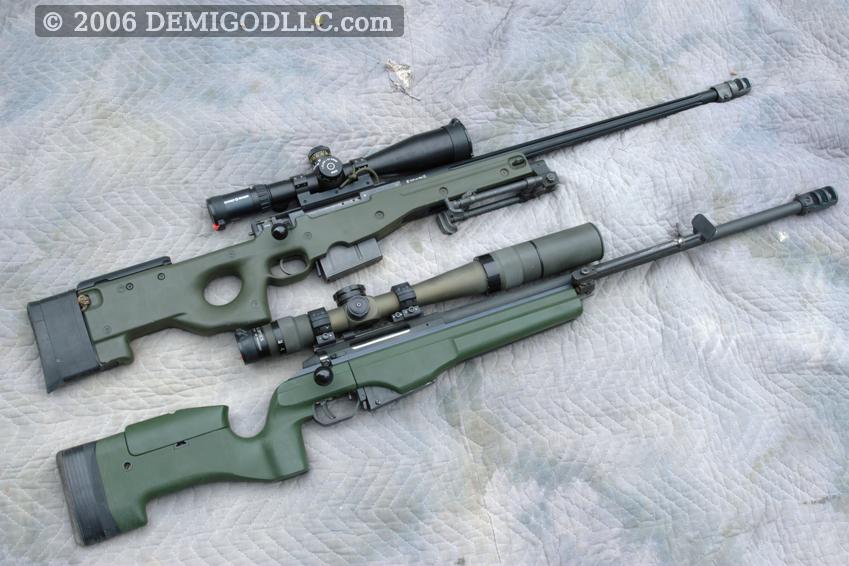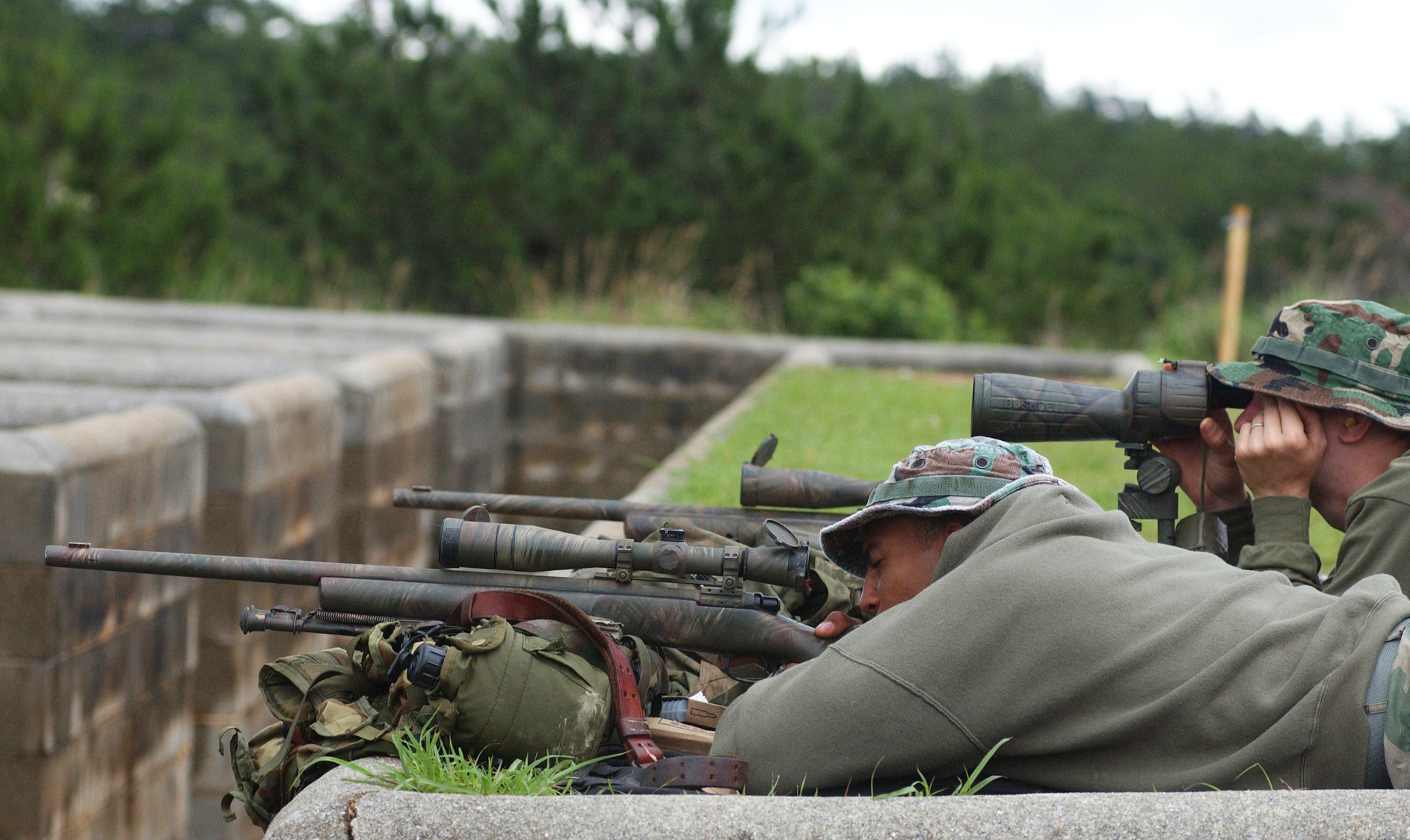(list taken from the TV series "Ultimate Weapons")
The Ulitmate Sniper Rifles:
10. Knight's Armament M110
Cartridge: 7.62x51mm NATO
Action: Gas Operated, rotating bolt
Weight: 16 lbs.
Length: 40.5 in (buttstock fully compressed),
46.5 in (buttstock fully compressed and suppressor attached)
Barrel length: 20 in.
Rate of Fire: Semi-Automatic
Effective Range: 800 meters
Feed System: 10 or 20-round detachable box magazine
Place of Origin: USA
Service: War in Afghanistan, War in Iraq
Manufacturer: Knight's Armament Company
9. LWRC SABR 308
Cartridge: 7.62x51 mm NATO
Operation: Short-Stroke Gas-Piston
Weight: 8.2 lbs.
Effective Range: more than 1000 yards
Rate of Fire: Semi-Automatic
This Sniper Rifle was developed for the US Special Forces. This rifle can be used for close quarters combat and long range shooting which helps the sniper to get to position without carrying 2 guns. The SABR stands for the Sniper Assault Rebuttal Rifle.
8. Mcmillan Tac 50
Cartridge: .50 BMG
Operation: Rotary Bolt Action
Weight: 26 lbs.
Length: 57 in.
Barrel Length: 29 in.
Effective Range: 1600 meters
Feed System: 5 round detachable box magazine
Manufacturer: McMillan Brothers Rifle Co.
Service: War in Afghanistan
Place of Origin: USA
Two Canadian snipers of the Princess Patricia's Canadian Light Infantry regiment sniper team made the longest recorded sniper kills in history with this weapon in Afghanistan during Operation Anaconda, in the Shah-i-Kot Valley. In March 2002, Master Corporal Arron Perry killed an enemy combatant from 1.435 miles and Corporal Rob Furlong killed an enemy combatant from1.509 miles with 750 grain Hornady A-MAX very-low-drag bullets. These were the longest recorded kills by snipers in combat.
7. M40
Cartridge: 6.5x47 LAPUA
Operation: Bolt Action
Weight: M40A1: 14.48 lb
M40A3: 16.5 lb
Length: M40A1: 43.97 in
M40A3: 44.25 in
Barrel length: 610 mm (24 in) (1:12 right hand twist)
M40A1: Hart (6 lands and grooves)
M40A3: Schneider Match Grade SS #7 (6 lands and grooves)
Effective Range: 1000 yards
Feed System: 5-round integral box magazine
Sights: Scout Sniper Day Scope (SSDS)
Manufacturer: United States Marine Corps, Remington
Place of Origin: USA
Service: Iraq War, War in Afghanistan, Gulf War, Invasion of Grenada, Multinational Force in Lebanon, Vietnam War.
The M40 is a bolt-action sniper rifle used by the United States Marine Corps. It has four variants — the M40, M40A1, M40A3, and M40A5. The M40 was introduced in 1966. The changeover to the A1 model was completed in the 1970s, the A3 in the 2000s, and the A5 in 2009.
Each M40 is built from a Remington 700 bolt-action rifle, and is modified by USMC Armorers at Marine Corps Base Quantico, using components from a number of suppliers. New M40A3s are being built, and A1s are upgraded to A3s as they rotate into the armory for service and repair.
6. Stealth Recon Scout
Cartridge: .243 Winchester
7.62x51 mm (.308 Winchester)
.300 Winchester Magnum
.338 Lapua Magnum
Action: Bolt Action
Weight: 11.5 lb (.243 Winchester)
11 lb (7.62x51 mm)
12 lb (.300 Winchester Short Magnum)
12.37 lb (.338 Lapua Magnum)
Length: 33.5 in (.243 Winchester)
31.5 in (7.62x51 mm)
35.5 in (.300 Winchester Magnum)
37.5 in (.338 Lapua Magnum)
Barrel Length: 24 in (.243 Winchester)
22 in (7.62x51 mm)
26 in (.300 Winchester Magnum)
26 in (.338 Lapua Magnum)
Feed System: 5-round detachable box magazine (.338 Lapua Magnum)
6-round detachable box magazine (.300 Winchester)
7-round detachable box magazine (.243 Winchester, .308 Winchester)
Sights: Telescopic Sight
Manufacturer: Desert Tactical Arms
Place of Origin: USA
The Stealth Recon Scout is notably unusual in that it is one of the few rifles that has a bullpup bolt-action layout. This gives the rifle a relatively compact design; claimed to be 11 inches shorter than conventional sniper rifles.
5. Accuracy International AS-50
Cartridge:12.7x99 NATO
| Caliber: .50 BMG |
|---|
Weight: 31 lbs.
Length: 53.9 in.
Barrel Length: 692 mm
Effective Range: 1500 meters
Feed System: 5 or 10 round detachable box magazine
Place of Origin: United Kingdom
Manufacturer: Accuracy International
The AS50 enables operators to engage targets at very long range with high accuracy using explosive or incendiary ammunition. The AS50 employs a gas operated semi-automatic action and muzzle brake, allowing for lower recoil than the AW50 bolt action rifle and faster target acquisition.
4. Model 99 .416 Barrett
.416 Barrett Barrett M99
Projectile: .416 (396 grains) Operation: Single Shot Bolt Action
Bullet Diameter: .416 in. Weight: 25 lbs. or 23 lbs.Neck Diameter: .465 in. Length: 50 in. or 47 in.
Shoulder Diameter: .732 in. Barrel Length: 32 in. or 29 in.
Base Diameter: .797 in. Cartridge: .50 BMG
Case Length: 3.27 in. .416 Barrett
Overall Length: 4.58 in. Effective Range: 2600 meters
Case Capacity: 13 cm³ Feed System: Single Shot
Designer: Ronnie Barrett Manufacturer: Barrett Firearms Co.
Place of Origin: USA Place of Origin: USA
3. Accuracy International AWSM
Caliber: .338 Lapua Magnum
Operation: Bolt Action
Weight: 14.9 lbs.
Length: 1200 mm (.300 Win. Mag.)
1230 mm (.338 Lapua Magnum)
Barrel Length: 26 in. (.300 Win. Mag.)
27 in. (.338 Lapua Magnum)
Effective Range: 1,100 metres (.300 Winchester Magnum)
1,500 metres (.338 Lapua Magnum)
Feed System: 5-round detachable box magazine
Service: Afghanistan War, Iraq War
Manufacturer: Accuracy International
Sights: detachable aperture type iron sights day or night optics
Place of Origin: United Kingdom
2. Barrett M107
Cartridge: 12.7x99 mm NATO
.416 Barrett
Operation: Short Recoil
Rate of Fire: Semi-Automatic
Weight: 29.7 lbs.
Length: 57 inches (with 29 inch barrel)
48 inches (with 20 inch barrel) (M82A1)
Barrel Length: 29 inches
20 inches
Effective Range: 1800 meters
Feed System: 10-round detachable box magazine
Sights: Fixed front, adjustable rear sight; MIL-STD-1913 rail provided for optics
Manufacturer: Barrett Firearms Manufacturing
Place of Origin: USA
The M82 (called as the M107 by the military) is a recoil-operated, semi-automatic anti-materiel rifle developed by the American Barrett Firearms Manufacturing. A heavy SASR (Special Application Scoped Rifle), it is used by many armies around the world. It is also called the "Light Fifty" for its .50 caliber BMG chambering.
1. CheyTac M200 Intervention LRSS
Cartridge:.408 CheyTac
.375 CheyTac
Operation: Bolt Action
Weight: 27 lbs.
Length: 53 in (stock extended)
46¾ in (stock collapsed) (M-200)
Barrel Length: 29 in. (standard w/ 1:13 twist M-200)
26 in. (optional)
Effective Range: 2000+ meters (M-200)
2000+ meters (M-200 Carbine)
1500+ meters [M-200 CIV (Civilian)]
Feed System: 7-round detachable box magazine
Sights: Day Optics/ Night Optics
Designer: Randy Kobzeff
Manufacturer: CheyTac LLC and Randy Kobzeff
Place of Origin: USA

















